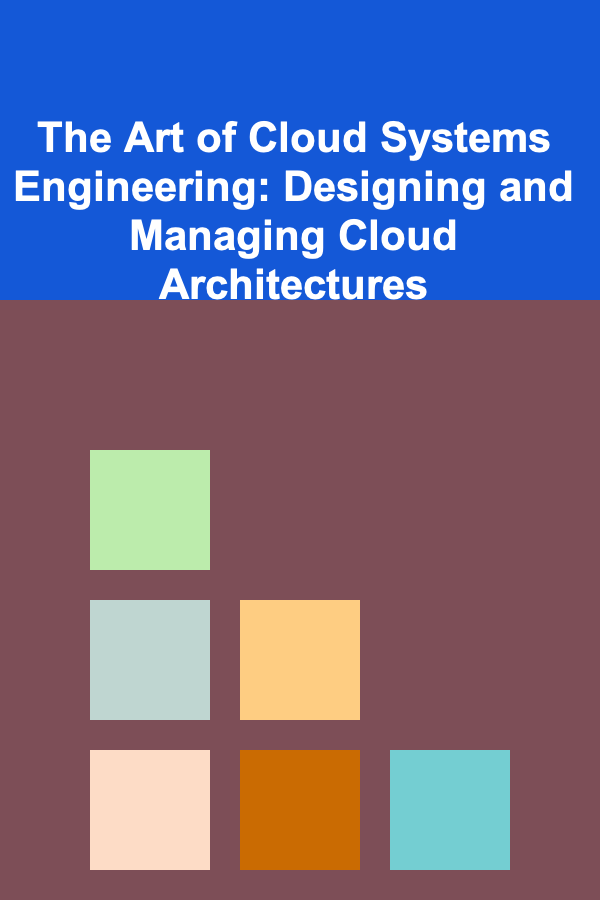
The Art of Cloud Systems Engineering: Designing and Managing Cloud Architectures
ebook include PDF & Audio bundle (Micro Guide)
$12.99$6.99
Limited Time Offer! Order within the next:

Cloud computing has become the backbone of modern enterprise IT systems. Its scalability, flexibility, and cost-effectiveness have revolutionized the way businesses operate and deliver services. As more organizations move their infrastructures to the cloud, the role of cloud systems engineers has become crucial. Designing and managing cloud architectures is not just about understanding cloud technologies; it requires a deep understanding of system design, operational efficiency, security, cost management, and scalability.
In this article, we'll explore the key principles and actionable steps for mastering cloud systems engineering. Whether you're responsible for designing cloud solutions from the ground up or optimizing existing architectures, understanding the core concepts of cloud systems engineering will enable you to build scalable, secure, and cost-effective cloud infrastructures.
Understanding the Cloud: Key Concepts and Principles
1.1 The Cloud Computing Stack
Cloud computing is a layered stack that allows businesses to leverage technology resources as services. It's important to understand each layer of the cloud stack to design systems effectively:
- Infrastructure as a Service (IaaS): Provides virtualized hardware resources like storage, compute power, and networking. Example: Amazon EC2, Google Compute Engine, Microsoft Azure Virtual Machines.
- Platform as a Service (PaaS): Offers a platform that allows developers to build and deploy applications without managing the underlying hardware. Example: Google App Engine, Azure App Service.
- Software as a Service (SaaS): Delivers fully managed software applications over the internet, eliminating the need for users to install and run applications on their own machines. Example: Google Workspace, Microsoft 365.
- Function as a Service (FaaS): Also known as serverless computing, FaaS allows developers to run code in response to events without managing the server infrastructure. Example: AWS Lambda, Azure Functions.
1.2 Key Cloud Deployment Models
There are different cloud deployment models that businesses can choose from based on their specific needs. Understanding the differences between these models is essential for designing the right solution:
- Public Cloud: Cloud services provided by third-party vendors that are shared among multiple organizations. Example: AWS, Microsoft Azure, Google Cloud Platform.
- Private Cloud: Cloud infrastructure dedicated to a single organization, either hosted on-premises or by a third-party provider.
- Hybrid Cloud: A combination of public and private cloud models, allowing businesses to move workloads between them as needed.
- Multi-cloud: The use of multiple cloud providers to avoid vendor lock-in, increase redundancy, and optimize cost and performance.
Core Responsibilities of a Cloud Systems Engineer
Cloud systems engineers are responsible for designing, deploying, and managing cloud-based infrastructures. Their roles vary depending on the organization's cloud strategy, but the following core responsibilities are critical:
2.1 Architecture Design
Designing a robust cloud architecture is the cornerstone of a cloud systems engineer's role. Cloud architecture design involves defining how different components, such as servers, databases, storage, and networking, interact and scale within the cloud environment.
- High Availability (HA): Designing systems with redundancy in place to minimize downtime and ensure that applications are available even in the event of a failure. Using multiple availability zones and regions is key to achieving high availability.
- Scalability: Systems should be designed to scale horizontally or vertically, depending on the requirements. Horizontal scaling involves adding more instances to handle traffic, while vertical scaling increases the resources (e.g., CPU or RAM) of an existing instance.
- Elasticity: The ability to automatically scale resources up or down based on real-time demand. This is typically achieved using auto-scaling groups, which adjust the number of instances in response to fluctuating workloads.
2.2 Security Design and Implementation
Security is paramount in cloud system design. With sensitive data being stored and processed on the cloud, it's essential to implement security best practices.
- Encryption: Ensure that all data at rest and in transit is encrypted. Use encryption algorithms that comply with industry standards, such as AES-256 for data at rest.
- Identity and Access Management (IAM): Implement strong IAM policies, ensuring users only have access to the resources they need. Tools like AWS IAM, Azure AD, or Google Cloud IAM can help define roles and manage permissions.
- Network Security: Design secure cloud networks using Virtual Private Clouds (VPCs), subnets, firewalls, and security groups. This prevents unauthorized access and enables segmentation of sensitive data.
- Compliance: Stay updated with regulatory compliance requirements (e.g., GDPR, HIPAA) and ensure that the cloud architecture meets these standards.
2.3 Cost Management and Optimization
One of the primary benefits of cloud computing is the pay-as-you-go pricing model, but this can also lead to unexpectedly high costs if not managed properly. Cloud systems engineers need to implement strategies to monitor and control costs.
- Resource Sizing: Avoid over-provisioning by accurately predicting resource needs. Use tools like AWS Trusted Advisor or Azure Cost Management to monitor usage and optimize resource allocation.
- Reserved Instances vs. On-Demand: Leverage reserved instances for long-term workloads, which can offer significant savings compared to on-demand pricing.
- Right-sizing and Auto-scaling: Right-size instances to match the workload requirements. Implement auto-scaling to ensure that you're only paying for the resources you need when you need them.
2.4 Monitoring and Logging
Continuous monitoring and logging are crucial for maintaining the health of cloud systems. Proactive monitoring helps detect issues before they affect users, and logging provides detailed insights for troubleshooting.
- Cloud Monitoring Tools: Use tools like AWS CloudWatch, Azure Monitor, or Google Stackdriver to collect performance data, track uptime, and identify resource bottlenecks.
- Log Aggregation and Analysis: Aggregate logs from various sources (e.g., application logs, system logs) and use tools like ELK Stack (Elasticsearch, Logstash, Kibana) or Cloud-native logging services to analyze them for potential issues.
- Alerting and Automation: Set up automated alerts for critical performance thresholds (e.g., CPU usage, memory usage) and trigger automated remediation actions when necessary.
Designing Cloud Architectures: Actionable Steps
Designing an effective cloud architecture involves several steps that ensure the system is scalable, secure, cost-efficient, and reliable.
3.1 Define Requirements
Before you begin designing, gather detailed requirements from stakeholders. This includes:
- Business Requirements: What are the company's objectives for moving to the cloud? Are there specific performance, security, or compliance requirements?
- Technical Requirements: What applications and workloads will be hosted in the cloud? What are their resource needs in terms of storage, compute power, and networking?
- Budget Constraints: Understand the available budget and ensure that the design stays within the financial limits while providing scalability and performance.
3.2 Select the Right Cloud Provider
Choosing the right cloud provider is critical. Evaluate the strengths and weaknesses of each platform (AWS, Azure, Google Cloud) based on your requirements:
- Global Reach: Does the cloud provider have data centers in the regions where you need them?
- Service Availability: Does the provider offer the specific services required for your architecture (e.g., databases, machine learning, container services)?
- Pricing Structure: Compare the pricing models to ensure that the provider fits within your budget, considering long-term scaling needs.
3.3 Design for High Availability and Fault Tolerance
Design your cloud architecture with high availability (HA) and fault tolerance in mind. This can be achieved by:
- Multi-region Deployments: Distribute resources across different geographical regions to protect against regional outages.
- Auto-scaling: Automatically scale resources based on demand to handle traffic spikes without manual intervention.
- Load Balancing: Use load balancers to distribute traffic evenly across instances, ensuring no single point of failure.
3.4 Security and Compliance
Ensure that your cloud architecture meets the necessary security standards and regulatory requirements. Design the following:
- Data Encryption: Encrypt all sensitive data at rest and in transit.
- Network Segmentation: Use subnets and security groups to isolate different components of the application and minimize exposure.
- Access Control: Use the principle of least privilege (PoLP) to restrict access to sensitive resources, and enforce multi-factor authentication (MFA) wherever possible.
3.5 Cost Optimization Strategies
Ensure that your cloud architecture is designed with cost optimization in mind. This includes:
- Choosing the Right Instance Types: Use compute instances that match the application's workload requirements.
- Spot Instances and Preemptible VMs: Use spot instances for non-critical workloads to reduce costs.
- Storage Optimization: Use different types of storage (e.g., object storage, block storage) based on the access frequency and performance needs.
Managing and Operating Cloud Systems
Once the architecture is designed and deployed, ongoing management and operation are crucial to maintain performance and minimize disruptions.
4.1 Automating Operations
Automation is key to efficiently managing cloud infrastructure. Use Infrastructure as Code (IaC) tools like Terraform, AWS CloudFormation, or Azure Resource Manager templates to automate the deployment and management of cloud resources.
- CI/CD Pipelines: Integrate continuous integration and continuous delivery (CI/CD) pipelines to automate the software deployment process, ensuring faster and more reliable updates.
4.2 Regularly Review and Optimize
Cloud systems require regular reviews to ensure they remain cost-effective and performant. Perform periodic audits of your architecture to identify opportunities for cost reduction, performance improvements, and security enhancements.
- Cost Audits: Use tools like AWS Cost Explorer or Azure Cost Management to track spending and find areas for optimization.
- Performance Tuning: Monitor resource usage and identify over-provisioned or under-utilized instances.
Conclusion
Cloud systems engineering is both an art and a science. It involves understanding the nuances of cloud technologies, designing for scalability and security, optimizing for cost, and continuously managing and improving the infrastructure. By mastering the principles of cloud architecture and focusing on key areas such as security, availability, performance, and cost, cloud systems engineers play a critical role in ensuring the success of cloud transformations within organizations.
The landscape of cloud computing continues to evolve, and staying up to date with new tools, best practices, and emerging trends will allow cloud systems engineers to remain effective and deliver robust solutions in this fast-paced domain.
Other Products

How to Make Smart Purchases During Holiday Sales and Discounts
Read More
How to Optimize Your Virtual Assistant's Workflow for Dropshipping Success
Read More
How to Sell Rare Coins on Online Numismatic Marketplaces: A Comprehensive Guide
Read More
How to Set Up a Home Party That's Kid-Friendly and Fun
Read More
How to Start Saving Money on Pet Food and Supplies Without Compromising Quality
Read More